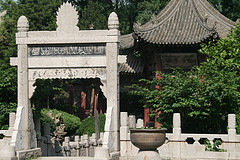A thought in Xi’an
Tuesday, May 20th, 2008 Leaving aside the Terracotta Warriors, the tomb of the first Chinese emperor Jingdi and the other highlights around Xi’an, the most interesting place within the city itself is the Great Mosque.
Leaving aside the Terracotta Warriors, the tomb of the first Chinese emperor Jingdi and the other highlights around Xi’an, the most interesting place within the city itself is the Great Mosque.
Islam has a long history in China, dating from the seventh century when the Prophet’s uncle – whose tomb is said to be in Guangzhou – journeyed to the Far East. But despite this long history of Islam in China and the presence of the largely Muslim western province of Xinjiang bordering the central Asian republics, the Great Mosque in Xi’an offers something you cannot find virtually anywhere else in the country: a Muslim place of worship built entirely in the style of a traditional Chinese Buddhist temple. I’ve always found this type of religious fusion to be fascinating wherever I’ve seen it around the world, and this was no different.
Xi’an is a monstrous city by anyone’s standards except China’s – with a population of eight million, it holds more people than Sydney and Melbourne put together – and the Great Mosque is one of the few havens of peace and tranquility within it. The 13,000 square metre grounds are beautiful and full of trees, birds (not caged) are chirping, and the eighth-century buildings are adorned with picturesque Arabic and Chinese calligraphy.
 There’s another reason for the serenity of the mosque, which is also the whole point of this post: there were no Chinese tourists there, and they were conspicious by their absence. All the major tourist attractions we’ve been to in Beijing and Xi’an have thronged with Chinese tourists, who tend to make up at least 95 per cent of the crowds. But in the Great Mosque, I don’t think I saw a single one, though quite a few foreign tourists were coming and going. The only conclusion is that the average Chinese person is not interested in Islam, or simply doesn’t like it. Since Islam is a part (albeit a small one) of their history and considering Muslims in the western provinces form one strata of the complicated multicultural Chinese society, this is a disappointment.
There’s another reason for the serenity of the mosque, which is also the whole point of this post: there were no Chinese tourists there, and they were conspicious by their absence. All the major tourist attractions we’ve been to in Beijing and Xi’an have thronged with Chinese tourists, who tend to make up at least 95 per cent of the crowds. But in the Great Mosque, I don’t think I saw a single one, though quite a few foreign tourists were coming and going. The only conclusion is that the average Chinese person is not interested in Islam, or simply doesn’t like it. Since Islam is a part (albeit a small one) of their history and considering Muslims in the western provinces form one strata of the complicated multicultural Chinese society, this is a disappointment.
In any case, we spent three days in Xi’an as part of a one-week break from work, taking in the famed warriors and another really impressive tomb as well as other attractions in and around the city, and are now in the delightful town of Pingyao which I’ll write about another time.
